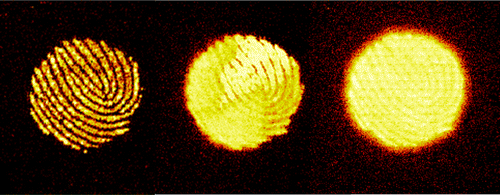The crime scene investigators on TV's popular CSI: Crime Scene Investigation series seem able to solve any mystery thanks to a little science and a lot of artistic license. But now there is a real-life technique that could outperform even fictional sleuths' crime-busting tools. Scientists report in ACS' journal Analytical Chemistry a way to tell how old fingerprints are. This could help investigators determine which sets are relevant and which ones were left long ago.
Law enforcement officials have long relied on fingerprints left behind by criminals to help solve cases. In addition to patterns of whorls, loops and arches specific to individuals, prints can also yield clues as to the owners' age and gender, as well as materials—such as explosives or make-up—that they may have touched. But determining just how long these residues have been at a crime scene is one aspect that has remained a challenge. The ability to date fingerprints would allow police to more easily rule certain suspects in or out of their investigations. Shin Muramoto and colleagues wanted to find a way to meet that need.
The researchers studied various molecules in fingerprints and found that a substance called palmitic acid migrates away from print ridges at a predictable rate. Based on this diffusion, the scientists could estimate how old a fingerprint was. Their findings apply to prints up to four days old, but they plan to expand that window to 10 days.
More information: Strategies for Potential Age Dating of Fingerprints through the Diffusion of Sebum Molecules on a Nonporous Surface Analyzed using Time-of-Flight Secondary Ion Mass Spectrometry, Anal. Chem., Article ASAP. DOI: 10.1021/acs.analchem.5b02018
Abstract
Age dating of fingerprints could have a significant impact in forensic science, as it has the potential to facilitate the judicial process by assessing the relevance of a fingerprint found at a crime scene. However, no method currently exists that can reliably predict the age of a latent fingerprint. In this manuscript, time-of-flight secondary ion imaging mass spectrometry (TOF-SIMS) was used to measure the diffusivity of saturated fatty acid molecules from a fingerprint on a silicon wafer. It was found that their diffusion from relatively fresh fingerprints (t ≤ 96 h) could be modeled using an error function, with diffusivities (mm2/h) that followed a power function when plotted against molecular weight. The equation x = 0.02t0.5 was obtained for palmitic acid that could be used to find its position in millimeters (where the concentration is 50% of its initial value or c0/2) as a function of time in hours. The results show that on a clean silicon substrate, the age of a fingerprint (t ≤ 96 h) could reliably be obtained through the extent of diffusion of palmitic acid.
Journal information: Analytical Chemistry
Provided by American Chemical Society






















